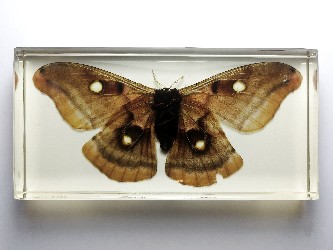











ANTHERAEA POLYPHEMUS MOTHEmbedded in clear epoxy resin |
 |
 |
 |
 |
 |
 |
 |
 |
 |
 |
 |
 |
|
Polyphemus Moth Antheraea polyphemus CLICK FOR DOWNLOAD PDF --------------------------------- Classification Phylum Arthropoda Class Insecta Order Lepidoptera Family Saturniidae Genus Antheraea Species A. Polyphemus
.............................. BUTTERFLY FIELD GUIDE OF THE SANTA MONICA MOUNTAINS
CLICK FOR DOWNLOAD PDF |
ANTHERAEA POLYPHEMUS Antheraea polyphemus, the Polyphemus moth, is a North American member of the family Saturniidae, the giant silk moths. It is a tan-colored moth, with an average wingspan of 15 cm . The most notable feature of the moth is its large, purplish eyespots on its two hindwings. The eyespots give it its name from the Greek myth of the cyclops Polyphemus. The species was first described by Pieter Cramer in 1776. The species is widespread in continental North America, with local populations found throughout subarctic Canada and the United States. The caterpillar can eat 86,000 times its weight at emergence in a little less than two months. Differentiating between sexes of this species is very easy. The most obvious difference is the plumose antennae. Males have very bushy antennae while females have moderately less bushy antennae. The male's antennae are used to detect pheromones released by unmated females. Another difference is that the females are slightly larger in the abdomen due to carrying eggs. A surprising amount of variation occurs within this species. Color patterns can range from a reddish cinnamon to a dark brown, but are almost always a shade of brown. The Polyphemus moth uses defense mechanisms to protect itself from predators. One of its most distinctive mechanisms is a distraction display that serves to confuse, or simply distract, predators. This involves the large eyespots on its hindwings, which give the moth its name (from the cyclops Polyphemus in Greek mythology). Eyespots are also startle patterns, a subform of distraction patterns, used for camouflage via deceptive and blending coloration. Most startle patterns are brightly colored areas on the outer body of already camouflaged animals.
When the eggs hatch, small yellow caterpillars emerge. As the caterpillars age, they molt five times (the fifth being into a pupa). Each instar is slightly different, but on their fifth and final instar, they become bright green with silver spots on their sides. They feed heavily on their host plant and can grow up to 3-4 inches long. They then spin cocoons of brown silk, usually wrapped in leaves of the host plant. The females emit pheromones, which the male can detect through his large, plumose (feathery) antennae. Males can fly for miles to reach a female. After the moths mate, the female spends the majority of the remainder of her life laying eggs, while the male may mate several more times. Adults of this family of moths have vestigial mouths, meaning their mouth parts have been reduced. Because of this, they do not eat and only live as adults for less than one week.
|